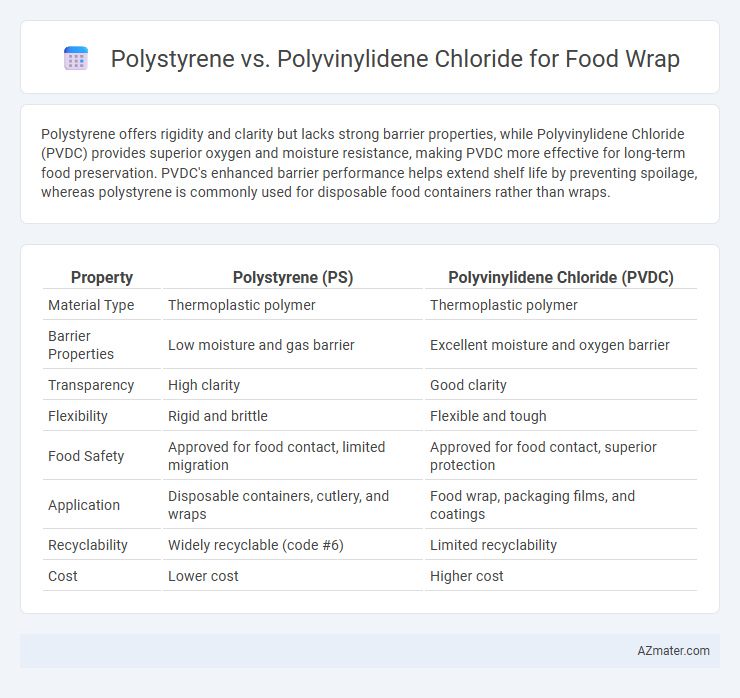Polystyrene offers rigidity and clarity but lacks strong barrier properties, while Polyvinylidene Chloride (PVDC) provides superior oxygen and moisture resistance, making PVDC more effective for long-term food preservation. PVDC's enhanced barrier performance helps extend shelf life by preventing spoilage, whereas polystyrene is commonly used for disposable food containers rather than wraps.
Table of Comparison
| Property | Polystyrene (PS) | Polyvinylidene Chloride (PVDC) |
|---|---|---|
| Material Type | Thermoplastic polymer | Thermoplastic polymer |
| Barrier Properties | Low moisture and gas barrier | Excellent moisture and oxygen barrier |
| Transparency | High clarity | Good clarity |
| Flexibility | Rigid and brittle | Flexible and tough |
| Food Safety | Approved for food contact, limited migration | Approved for food contact, superior protection |
| Application | Disposable containers, cutlery, and wraps | Food wrap, packaging films, and coatings |
| Recyclability | Widely recyclable (code #6) | Limited recyclability |
| Cost | Lower cost | Higher cost |
Introduction to Food Wrap Materials
Polystyrene and polyvinylidene chloride (PVDC) are prominent materials used in food wrap applications, each offering distinct protective properties. Polystyrene is valued for its rigidity, clarity, and excellent barrier against moisture but shows limited gas barrier performance and lower flexibility. PVDC provides superior oxygen and aroma barrier properties, making it highly effective for preserving food freshness and extending shelf life in various packaging solutions.
Overview of Polystyrene
Polystyrene is a synthetic aromatic hydrocarbon polymer known for its rigidity, transparency, and excellent moisture resistance, making it widely used in food packaging and food wrap applications. It offers good insulation properties and an effective barrier against oxygen, ensuring the preservation of food freshness. Compared to polyvinylidene chloride, polystyrene is less flexible but provides superior clarity and cost-effectiveness in food wrap solutions.
Overview of Polyvinylidene Chloride (PVDC)
Polyvinylidene Chloride (PVDC) is a highly effective polymer known for its superior barrier properties against oxygen, moisture, and aromas, making it ideal for food wrap applications. Its chemical structure provides excellent resistance to oils and solvents, enhancing the shelf life and freshness of packaged food compared to Polystyrene. PVDC films exhibit strong clarity, flexibility, and durability, which contribute to their widespread use in preserving perishable goods and maintaining food quality.
Barrier Properties: Oxygen and Moisture Protection
Polyvinylidene chloride (PVDC) exhibits superior barrier properties against oxygen and moisture compared to polystyrene (PS), making it highly effective for food wrap applications where extended shelf life is critical. PVDC films provide excellent oxygen impermeability, effectively preventing oxidation and spoilage, while also maintaining low water vapor transmission rates to preserve freshness. In contrast, polystyrene, while versatile and lightweight, offers lower resistance to gas and moisture permeation, limiting its use in high-barrier food packaging.
Food Safety and Chemical Resistance
Polyvinylidene Chloride (PVDC) food wrap offers superior chemical resistance compared to Polystyrene (PS), providing enhanced protection against oils, fats, and moisture, which is critical for food safety. PVDC's low permeability to gases and moisture helps maintain food freshness and reduces the risk of contamination, making it a preferred choice for preserving perishable items. In contrast, Polystyrene food wrap has limited chemical resistance and can leach styrene compounds, posing potential health risks during prolonged food contact.
Environmental Impact and Sustainability
Polystyrene, commonly used for food wrap, is less environmentally sustainable due to its non-biodegradable nature and difficulty in recycling, often contributing to long-term plastic pollution. Polyvinylidene Chloride (PVDC) offers superior barrier properties, reducing food waste by prolonging shelf life, yet its production involves chlorinated compounds that raise concerns regarding toxicity and environmental persistence. Choosing between polystyrene and PVDC for food wrap requires balancing the impact of plastic waste accumulation against chemical hazards, emphasizing the need for innovations in biodegradable or recyclable alternatives to enhance overall sustainability.
Cost Comparison
Polystyrene food wrap generally offers a lower cost compared to polyvinylidene chloride (PVDC) due to simpler manufacturing processes and more abundant raw materials. PVDC provides superior barrier properties against moisture and oxygen, but its higher production expenses lead to a significantly increased price per unit. Businesses often weigh cost-efficiency of polystyrene against the enhanced protective qualities of PVDC to determine the most suitable option for food packaging.
Common Applications in Food Packaging
Polystyrene is widely used in food packaging for disposable containers, trays, and rigid wrap due to its excellent clarity, rigidity, and insulation properties. Polyvinylidene chloride (PVDC) is preferred for food wrap applications requiring superior barrier protection against oxygen, moisture, and aromas, making it ideal for preserving freshness in meat, cheese, and deli products. Both materials contribute significantly to food packaging, with polystyrene favored for structural use and PVDC for its enhanced protective film qualities.
Regulatory and Health Considerations
Polystyrene and polyvinylidene chloride (PVDC) are both utilized in food wrap applications, but regulatory agencies have different guidelines due to their chemical properties. The U.S. Food and Drug Administration (FDA) permits the use of polystyrene for food contact, yet emphasizes limitations on styrene migration to ensure consumer safety. PVDC is favored for its superior barrier properties, with regulatory standards focusing on minimizing residual vinylidene chloride monomer, which can pose health risks if improperly regulated.
Choosing the Right Material for Food Wrap
Polystyrene offers excellent clarity and rigidity, making it ideal for showcasing fresh food while providing moderate moisture barrier properties. Polyvinylidene Chloride (PVDC) excels in oxygen and moisture barrier performance, enhancing shelf life and freshness, especially for perishable items. Selecting the right food wrap depends on prioritizing transparency and strength with polystyrene or superior barrier protection and extended preservation with PVDC.

Infographic: Polystyrene vs Polyvinylidene Chloride for Food Wrap
 azmater.com
azmater.com